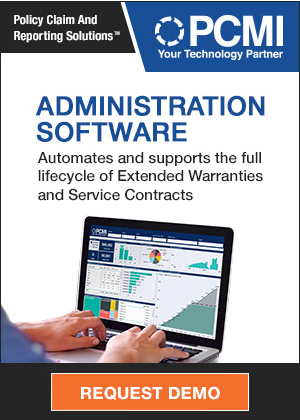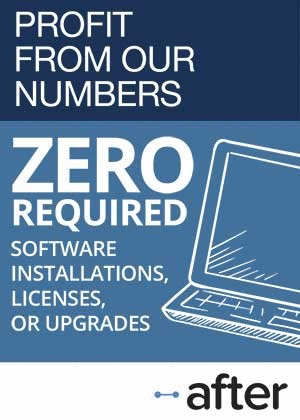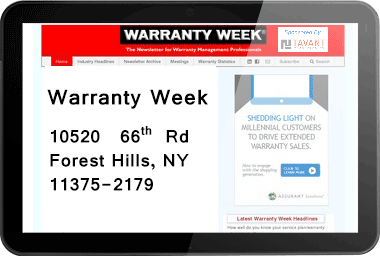Dell's Warranty Accounting:
While it came up short in terms of scandal and financial impact, Dell's accounting investigation did produce one benefit. At long last, the company separated its basic and extended warranty programs. And it turns out that extended warranty was even bigger than we thought.
It took more than a year to complete and required hundreds of people to complete it, but at long last Dell Inc. has released the results of its internal investigation into various accounting scandals. And the results are underwhelming in almost every respect but one: Finally, now we can see the exact numbers and separate balances for product warranty and extended warranty that we could only estimate a year or two ago.
Basically, this investigation came about after Dell was caught manipulating its accruals so that certain sectors of the company could "make their numbers" at the end of each quarter. But the restated numbers from those irregularities and others produced only minor changes to net income and earnings per share. They were a little larger than rounding errors but a lot smaller than the numbers coming out of the sub-prime mortgage mess. So if on a scale of 1 to 10 Enron and WorldCom were a 10, this was more like a 2.
Investors justifiably shrugged it off. Shares closed up 35 cents per share on the day of the announcement, and went up a bit further on unusually high trading volume the following day. There were the obligatory articles in the financial press, but the whole matter was largely forgotten by the weekend. Still, there were the predictable apologies and promises that it will never happen again.
Dell Statement
"We are disappointed that these errors and irregularities occurred," wrote chairman Michael Dell in an online statement. "But we also believe that the rigorous examination of our accounting and finance processes, along with the remedial actions taken and planned, have made and will continue to make Dell a far stronger company and provide a solid foundation on which to move the business forward and focus our energy on serving our customers. And we have a renewed focus on achieving and maintaining a strong control environment, high ethical standards and financial reporting integrity."
In Dell's annual report for the fiscal year ended Feb. 2, 2007, the company explained the investigation and its findings. Some highlights:
"The scope of the investigation was determined by Willkie Farr, in consultation with the Audit Committee and KPMG," Dell's statement said. "Willkie Farr and KPMG assembled an investigative team that ultimately consisted of more than 375 professionals, including more than 125 lawyers and 250 accountants. Investigative teams were deployed in our three geographic regions � Americas (including our corporate functions), EMEA, and APJ. Information and documents were gathered from company personnel worldwide. Using proprietary search software, the investigative team evaluated over five million documents. Investigative counsel also conducted over 200 interviews of approximately 150 individuals..."
In a section entitled, "Summary of Investigation Findings," Dell describes what its investigation uncovered:
"The investigation raised questions relating to numerous accounting issues, most of which involved adjustments to various reserve and accrued liability accounts, and identified evidence that certain adjustments appear to have been motivated by the objective of attaining financial targets. According to the investigation, these activities typically occurred in the days immediately following the end of a quarter, when the accounting books were being closed and the results of the quarter were being compiled. The investigation found evidence that, in that timeframe, account balances were reviewed, sometimes at the request or with the knowledge of senior executives, with the goal of seeking adjustments so that quarterly performance objectives could be met. The investigation concluded that a number of these adjustments were improper, including the creation and release of accruals and reserves that appear to have been made for the purpose of enhancing internal performance measures or reported results, as well as the transfer of excess accruals from one liability account to another and the use of the excess balances to offset unrelated expenses in later periods. The investigation found that sometimes business unit personnel did not provide complete information to corporate headquarters and, in a number of instances, purposefully incorrect or incomplete information about these activities was provided to internal or external auditors."
Down a bit, in a section entitled "Warranty Liabilities," Dell included more specific information:
"The issues related to Dell�s warranty liabilities include situations where certain vendor reimbursement agreements were incorrectly accounted for as a reduction in the estimate of the outstanding warranty liabilities. There were also instances where warranty reserves in excess of the estimated warranty liability, as calculated by the warranty liability estimation process, were retained and not released to the income statement as appropriate. Additionally, certain adjustments in the warranty liability estimation process were identified where expected future costs or estimated failure rates were not accurate."
Adjustments were made to the relevant accounts, which also required a restatement of revenue, expenses and net income. In the end, the effect were minor. For instance, in the fiscal year ended Feb. 3, 2006, restated revenue decreased by 0.2%, restated net income increased by 0.8%, and earnings per share went from $1.49 to $1.50.
Separate Basic & Extended Warranty
There was, however, one very important aspect to all the restatements. At long last, Dell has separated its basic and extended warranty accounting! And what a surprise it contains. It turns out that basic warranty expenses are much smaller, and extended warranty revenues are much larger, than anyone outside the company ever imagined.
Let's start with a revisit to past articles about Dell. In a January 9 newsletter from earlier this year, we looked at one possible scenario for separating Dell's basic product warranty and extended warranty accounting. Two years ago, in an October 15 newsletter, we looked at another possible scenario for separating the two, which even took a stab at figuring out what percentage of Dell's operating income came from extended warranties.
In Figure 1 below, we're summarizing what we believed to be true until we were proven so very wrong last week. We formerly believed that Dell's extended warranty program was growing so fast that it eclipsed the basic product warranty program two or three years ago. As it turns out, extended warranty has been massively much larger since at least the beginning of 2004, if not longer. They were never of comparable size.
The Old Estimates
Figure 1, based on previously filed financial reports, estimated that Dell began 2004 with a basic product warranty reserve of $1.669 billion and a pool of $1.025 billion in deferred extended warranty revenue. For anyone keeping track, that's a ratio of 62% to 38% on a combined balance of $2.694 billion.
By early 2006, we had estimated that the ratio had swung the other way, with 48% of $4.572 billion held as product warranty accruals and 52% as extended warranty deferred revenue. Boy were we wrong!
Figure 1
Dell's Basic vs. Extended Warranties:
Relative Reserve Fund Balances, 2004-2007
(estimated before the revisions)
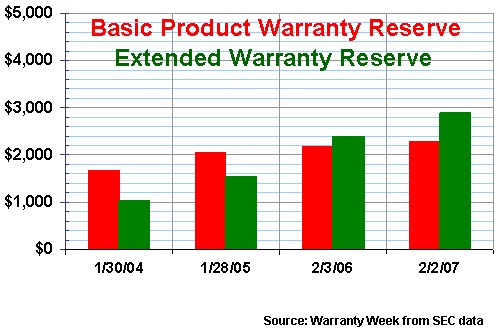
Just for giggles, we carried our assumptions through to the end of the most recent fiscal year, where we estimated 44% of $5.179 billion to be held for product warranty and 56% for extended warranty.
The New Estimates
When Dell released its restated financials, it eliminated the need to estimate the separations. Now we know them for sure. Figure 2 includes the actual fund balances held for product warranty and extended warranty from Jan. 30, 2004 to Feb. 2, 2007. As is obvious, extended warranty funds have never been close to equal with product warranty funds.
As of Jan. 30, 2004, the ratio was 24% to 76%. By Feb. 2, 2007 it was 18% to 82%. In other words, it was never either slightly above or slightly below 50/50. It was never even close. Instead, the extended warranty fund went from three times larger to more than four times larger.
Figure 2
Dell's Basic vs. Extended Warranties:
Relative Reserve Fund Balances, 2004-2007
(estimated after the revisions)
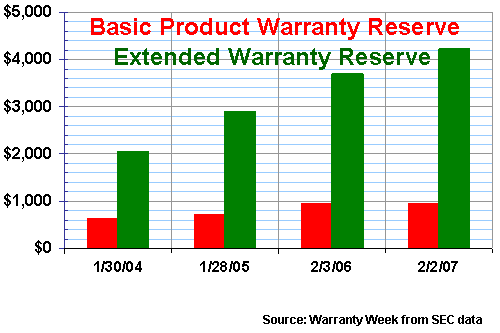
The combined balances had also changed in the restatements, but only slightly. As of Jan. 30, 2004, the combined balances decreased by $8 million to $2.686 billion. The combined balances a year later were revised up by $32 million. As of Feb. 3, 2006, the combined balances had increased by $86 million. And of course, the combined balances as of Feb. 2, 2007 had never before been announced, so there was no revision required.
Traditionally, manufacturers have kept basic and extended warranty in separate accounts. For instance, in that Oct. 25, 2005 newsletter, the basic and extended warranty operations of Apple Inc. and Gateway Inc. were also profiled, based on the way they disclosed their separate accounts. In fact, of the 900 manufacturers tracked by Warranty Week, only Dell, Cummins Inc. and American Standard have ever combined their basic and extended warranty fund balances.
Still No Comment
Dell declined to comment back in 2005 upon our estimates of how its accounts should be separated. This week, the company once again declined to comment upon our analysis. If at some future point they should choose to confirm or refute these conclusions, their input will be welcome.
Then again, while the company had the opportunity to correct our mistaken estimates two years ago, what we're presenting here is more fact-based. The problem is that Dell's revision and separation of its warranty accounts went only as far back as early 2004, and did not cover 2003. In addition, the revisions for 2004 came only in the annual statement, and not any of the individual quarterly reports. So we still need to make some estimates.
In Figure 3, we've attempted to track the balance in the basic product warranty reserve fund since early 2003. But, the first four quarters are still estimates based on inappropriately combined data, and the next four are quarterly estimates based on annual data. However, the most recent 11 quarters are based on the newly revised and separated accounting.
Figure 3 shows a warranty reserve that has slowly grown from $633 million as of Jan. 30, 2004 (1Q04 on this chart) to $722 million a year later (1Q05), to $951 million by Feb. 3, 2006 (1Q06), and finally $958 million by Feb. 2, 2007 (1Q07). It never exceeded $1 billion in size.
Figure 3
Dell's Warranty Reserves, 2003-2007
(in millions of dollars and months of capacity)

We'll spare you the old numbers we had before. Suffice it to say that we had assumed the warranty reserve was gradually increasing in size and had reached $2.2 billion by early 2005. In terms of capacity to pay claims, we had estimated that it peaked at 21 months in late 2004. As Figure 3 shows, it had never exceeded 12 months, meaning that Dell has always kept a bit under a year's worth of reserves on hand to pay future claims (about right given the average length of its warranties).
Revisions to Claims & Accrual Totals
The other major correction we need to make is to the figures for warranty claims and accruals. Dell restated its dollar figures for both metrics, and also restated its revenue figures, so the percentages calculated from those figures changed significantly.
Dell formerly published a combined figure for deferred extended warranty revenue and product warranty accruals. Now it publishes those figures separately. Dell formerly published a combined total for all claims paid, be they from product warranty or extended warranty policies. Now, we believe, the company publishes only the product warranty figures.
We specifically asked for clarification on this point but have not yet received a reply. But in comparing the old and the new figures, we noticed that claims for the year ended Jan. 28, 2005 dropped from $1.176 billion in the old report to $763 million in the new report. Does that mean $413 million of those were extended warranty claims? Likewise, in the following fiscal year claims were revised down by $489 million. Was this the extended warranty share?
In Figure 4, we're tracking just the now-separated product warranty figures for claims and accruals. As can be seen, the claims and accrual rates we used to think were closer to 4.0% have actually been below 3.0% most of the time, with the exception of the dramatic spike in the quarter covering August to October 2005 (4Q05).
Figure 4
Dell's Warranty Claims & Accruals, 2003-2007
(in percent of sales and millions of dollars)
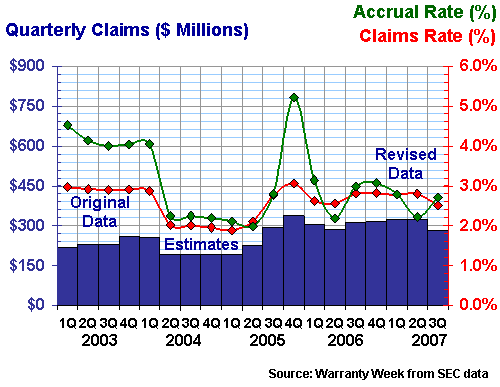
As with Figure 3, the 2003 data is the same as before. It just goes to show how things looked when basic product warranty and extended warranty accounts were combined. And then the 2004 data is estimated based on a single annual report chopped into four pieces. But the most recent 11 quarters are derived from the restatements released by Dell last week.
There is one more dramatic effect that we're not going to reduce to graphs just yet. And that's got to do with the way that Dell's new accounting has revised the totals down for both the computer industry and for manufacturers in general. Already, we have revised the claims totals downward by some half a billion dollars per year for all U.S. manufacturers, to $27.6 billion in calendar 2006, and $26.9 billion for calendar 2005. But we'll leave the exact analysis until the end of this year, which has only eight weeks left to it.
Announcing a Global Automotive Warranty Survey
BearingPoint, the Automotive Industry Action Group (AIAG), the Original Equipment Suppliers Association (OESA), the European Association of Automotive Suppliers (CLEPA), and Warranty Week are jointly sponsoring a global automotive warranty survey.
Bob Baxendale, a senior manager in the automotive practice at BearingPoint, said that emails and news bulletins are now going out from key members of the various warranty councils and early warning standards teams of these sponsors, telling their co-workers that the survey is now available and will remain online throughout the month of November.
This survey will examine how automotive OEMs and suppliers are working together more effectively to deliver a higher quality experience for the consumer. More specifically, the survey will provide information and insight for OEMs and suppliers to:
- Increase consumer satisfaction and loyalty,
- Improve collaboration among supply chain partners,
- Reduce incident rates and improve part and vehicle quality,
- Reduce time to identify and correct concerns (detection-to-correction), and
- Reduce overall cost of warranty.
The questions are in English, but to encourage more people in Europe and Asia to take the survey, it has also been translated into Chinese, French, Japanese, and Portuguese, with additional translations expected soon into Spanish and German.
Baxendale said the survey should take around 20 or 30 minutes to complete. If that can't be done in one sitting, it can be split up into multiple sessions. All respondents who complete the survey and include their contact info will receive a copy of the results, and will be entered into a contest to win a Garmin nüvi GPS receiver. The names of all participants will remain confidential.
Results are expected in January. BearingPoint will present the results at the next Warranty Chain Management Conference in San Diego. OESA and AIAG may sponsor additional breakfast meetings where their members can discuss the results with the BearingPoint team, Baxendale said. "We've also talked about setting up a Webinar for people who are not local," he added. "And we've been asked by CLEPA to do a meeting with their members, and to do a separate report on the European suppliers."
The IWCM Launches a Best Paper Award for 2008
 The Institute of Warranty Chain Management (IWCM) is pleased to launch a contest to encourage the creation and documentation of ideas and best practices in the warranty industry. Authors are invited to submit papers on warranty-related subjects which encompass the whole warranty value chain.
The Institute of Warranty Chain Management (IWCM) is pleased to launch a contest to encourage the creation and documentation of ideas and best practices in the warranty industry. Authors are invited to submit papers on warranty-related subjects which encompass the whole warranty value chain.
Glen Griffiths, president of the Institute, said it's part of an effort to generate content, which in turn will be offered to members. "We want to encourage people to write papers about warranty," he said. Basically, there are numerous PowerPoint slide decks floating around, but not a whole lot of Word documents.
Papers must be written in English and should contain a minimum of 5,000 and a maximum of 10,000 words and must include an executive summary and/or abstract as part of the word count. Papers must be submitted to the IWCM via email to Alison.Griffiths@iwcm.org by 5pm PST on Wednesday, January 16, 2008. The winner of the competition will be informed via email by Thursday, January 31, 2008, and will be announced publicly at the WCM Conference.
Papers will be judged on relevance and comprehensiveness of subject content, originality and contribution to warranty thinking. The paper determined by the IWCM review committee as winning this competition, based on the above criteria, will be invited to present their paper at the Warranty Chain Management Conference in San Diego. The winner will qualify for a round trip coach class ticket to San Diego (up to $1,000), three nights hotel accommodation at the Hyatt Regency and entrance to the WCM Conference itself (total value of $2,900).
Subjects eligible for the award include, but are not restricted to:
- Warranty Management,
- Warranty Management Systems,
- Managing the End-to-end Warranty Chain,
- Warranty Policy,
- Warranty Administration and Registration,
- Warranty Tools and Techniques,
- Early Warning Systems,
- Warranty Service and Support Chain,
- Warranty Logistics and Supply Chain,
- Extended Warranties,
- Warranty Benchmarking and Metrics,
- Warranty Cost reduction,
- Design for Warranty, and
- Finance aspects of Warranty.
All decisions by the IWCM review committee on the winner of the competition are considered final. This prize is not transferable. A substitute cash prize of $750 will be available if the winner is unable to attend or present at the WCM conference.
The Chief Information Officer plays a pivotal role to iron out the initial impediments before laying out a smooth track for warranty management in any enterprise. This article brings out the different sources of warranty data, a collaboration model for warranty data, the business dynamics of multiple stakeholders with respect to warranty management and displays ways to assess and improve warranty information maturity.November 14, 2007





